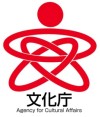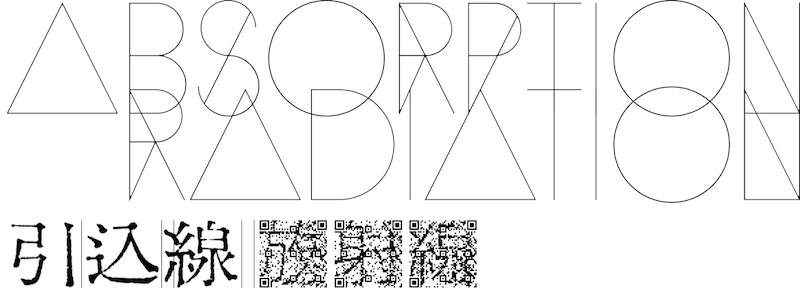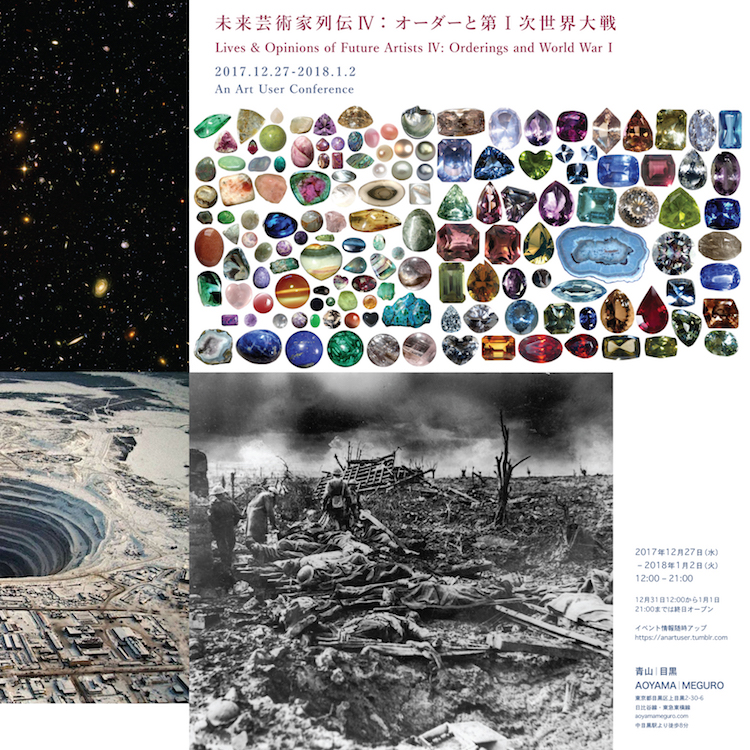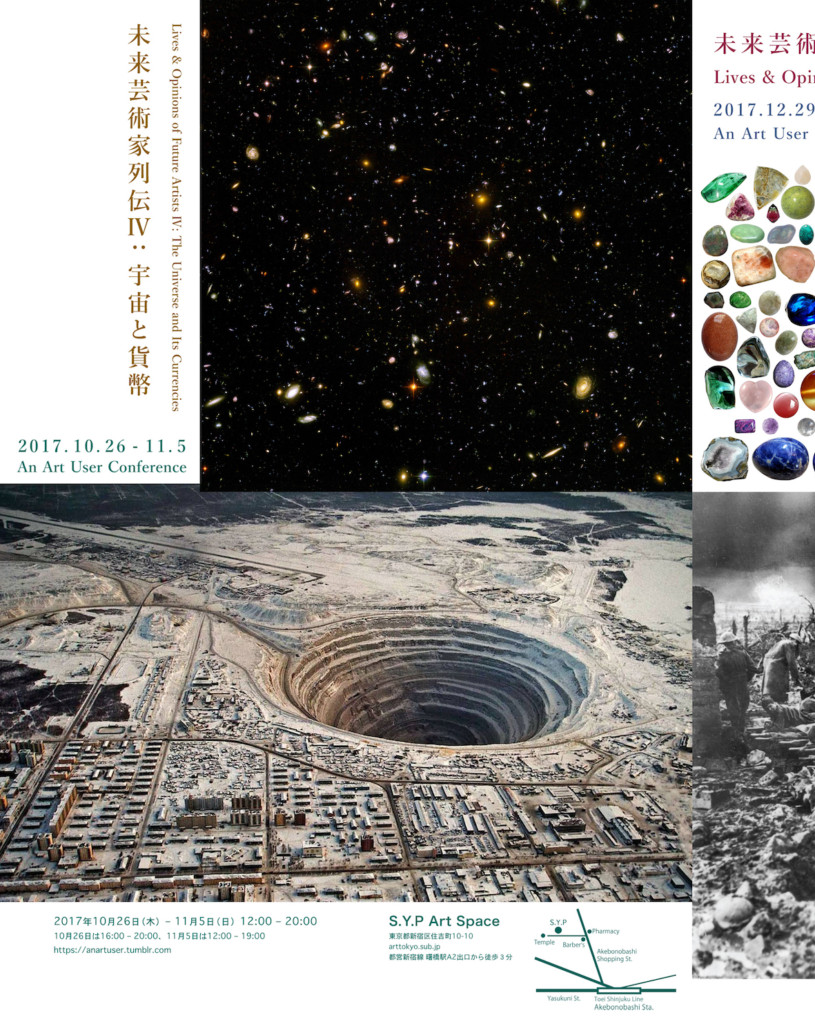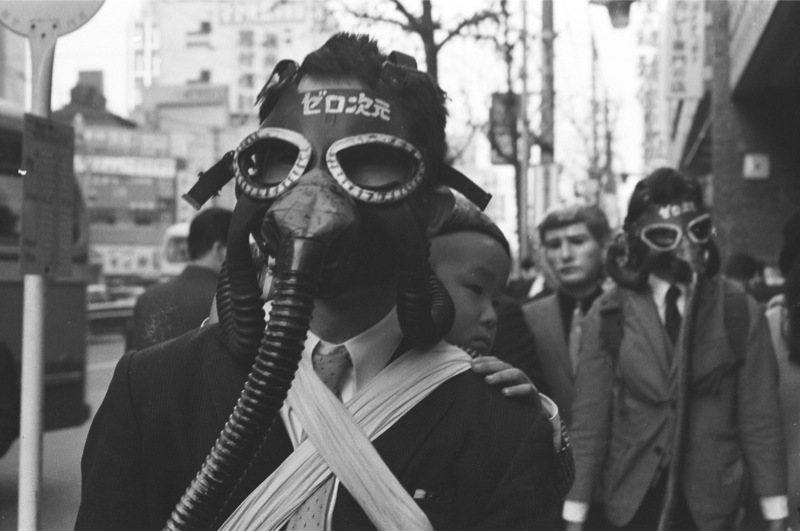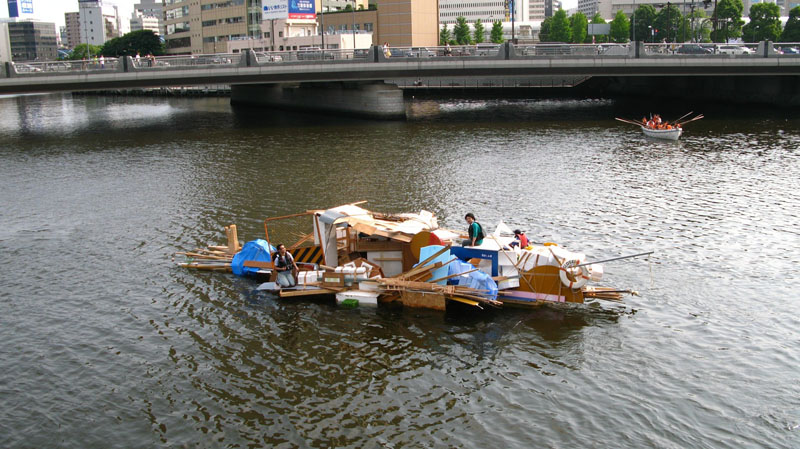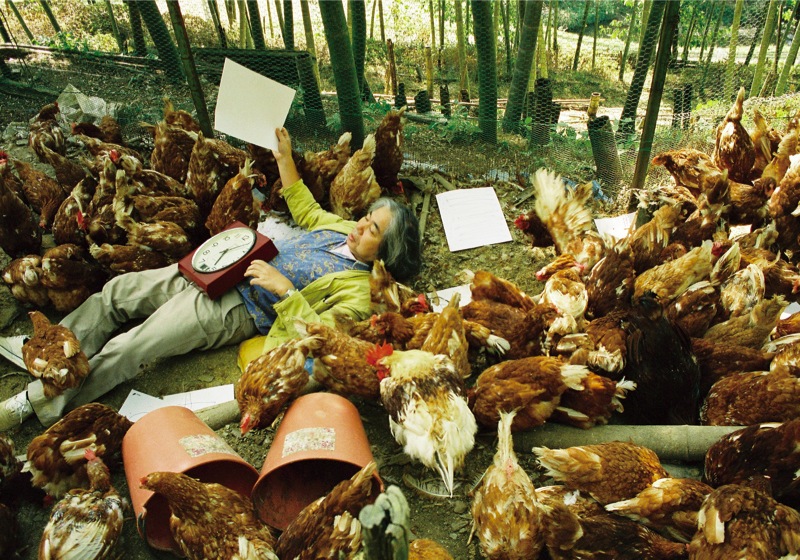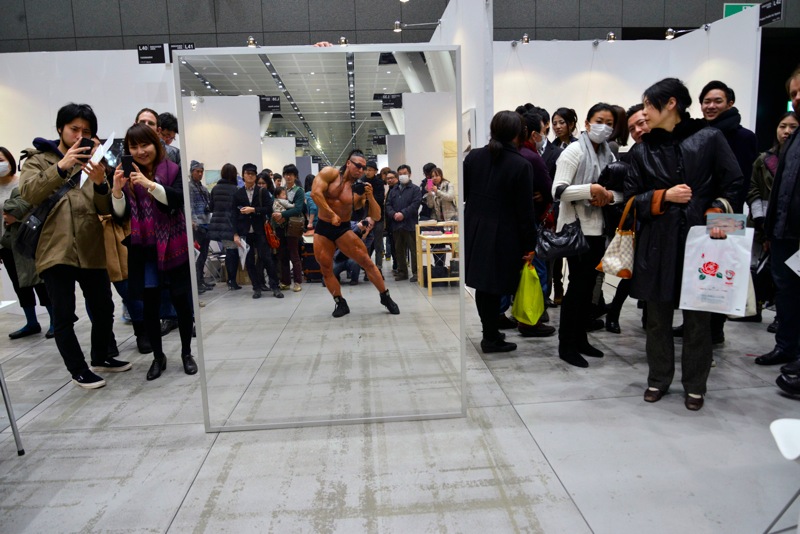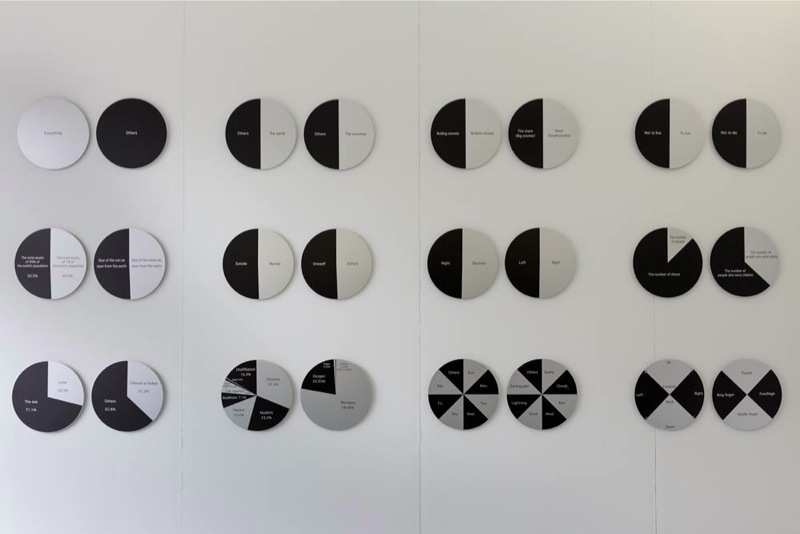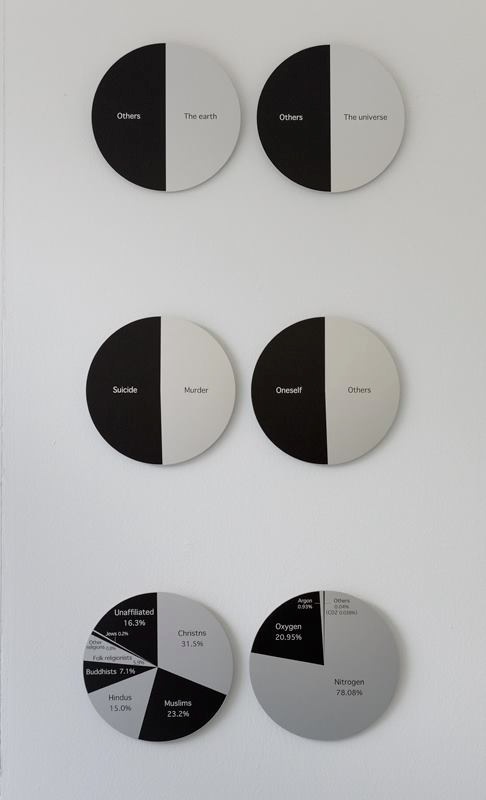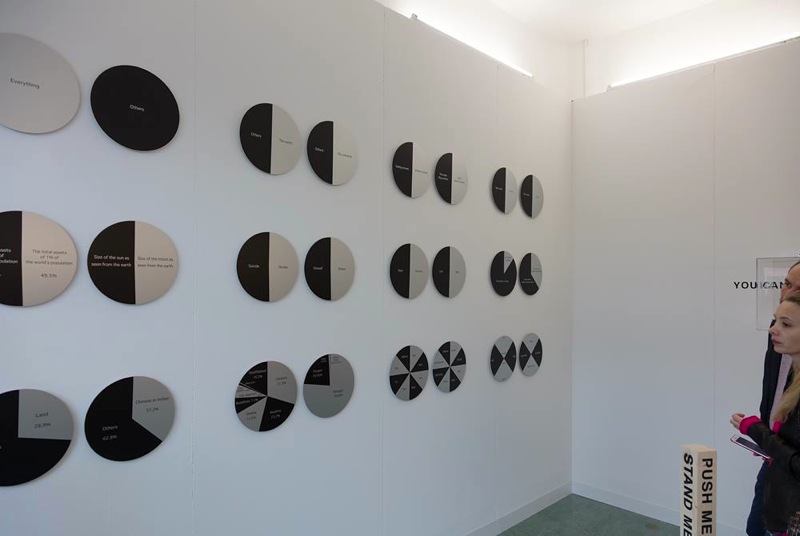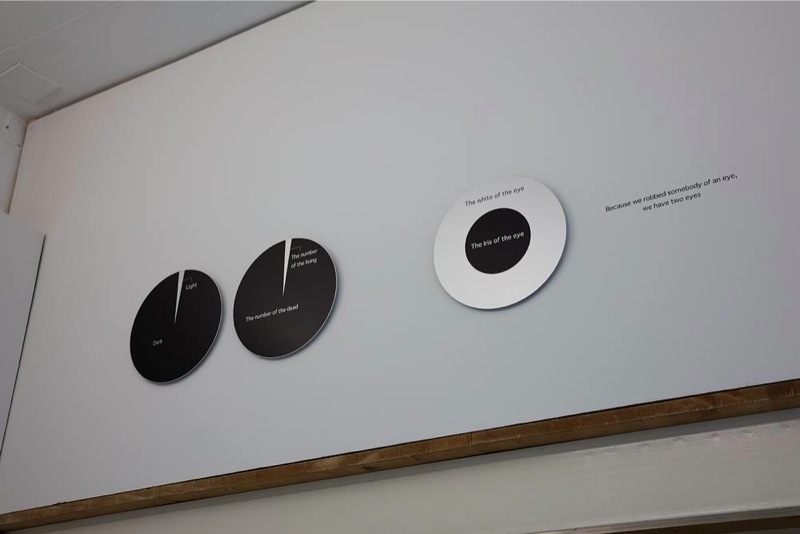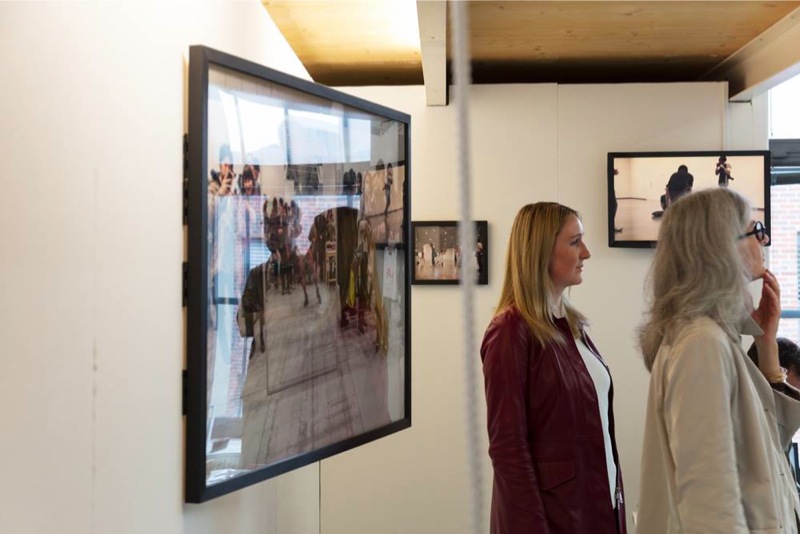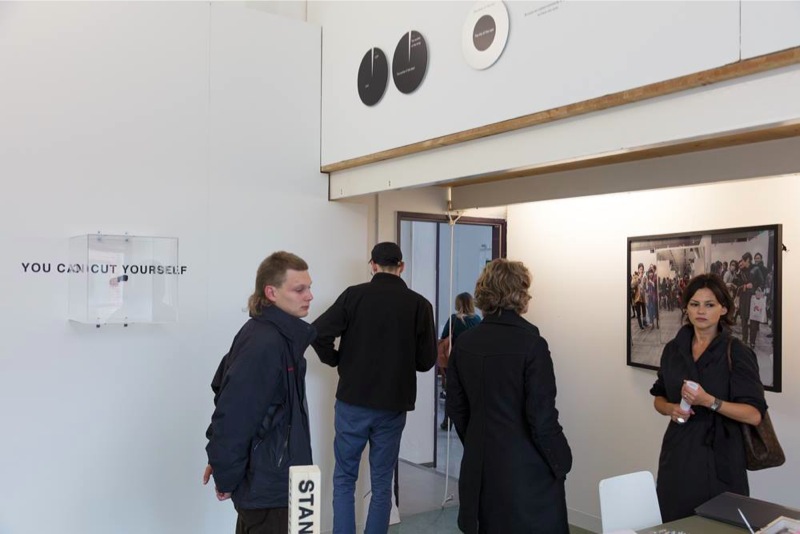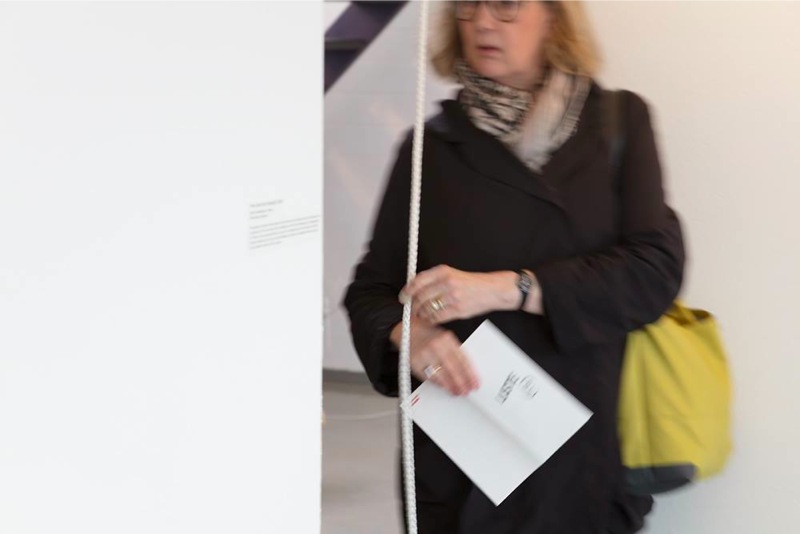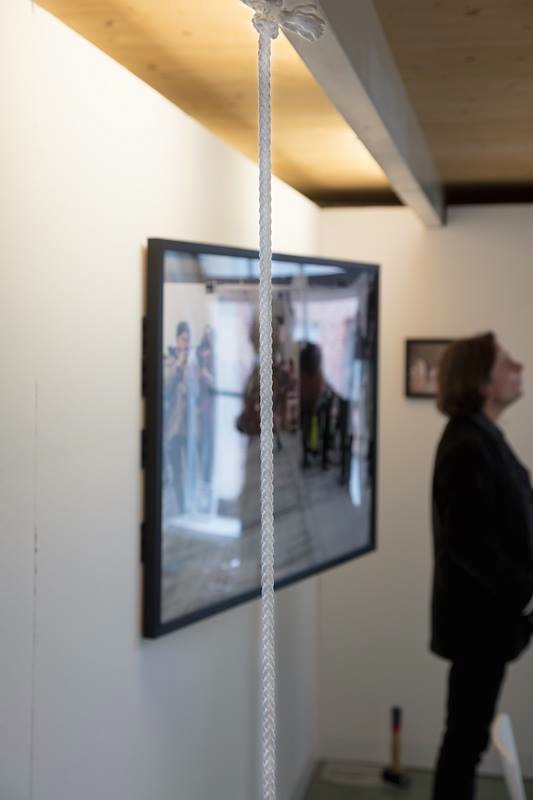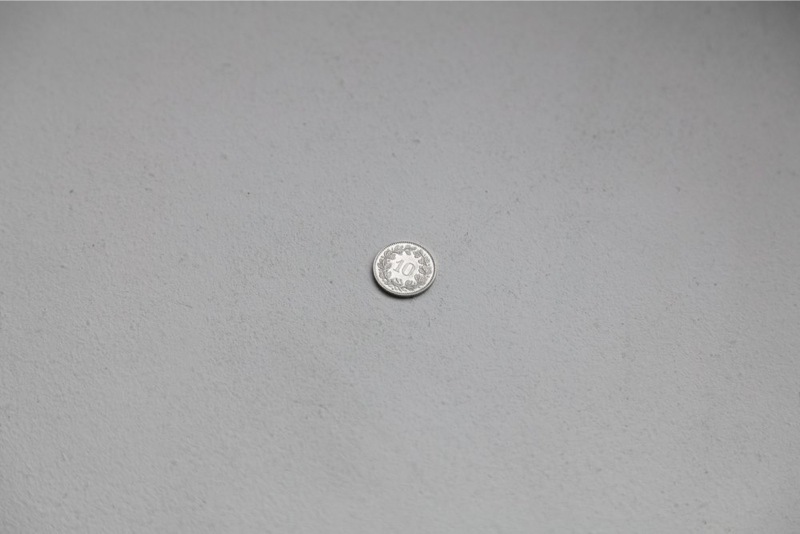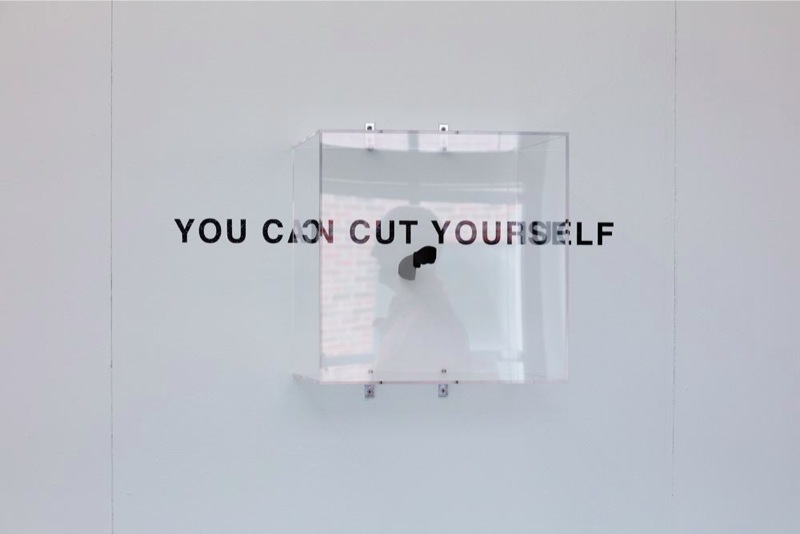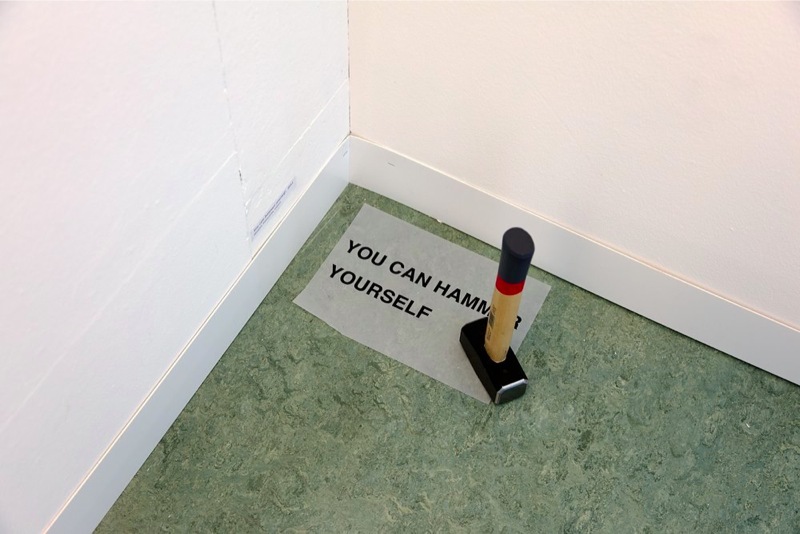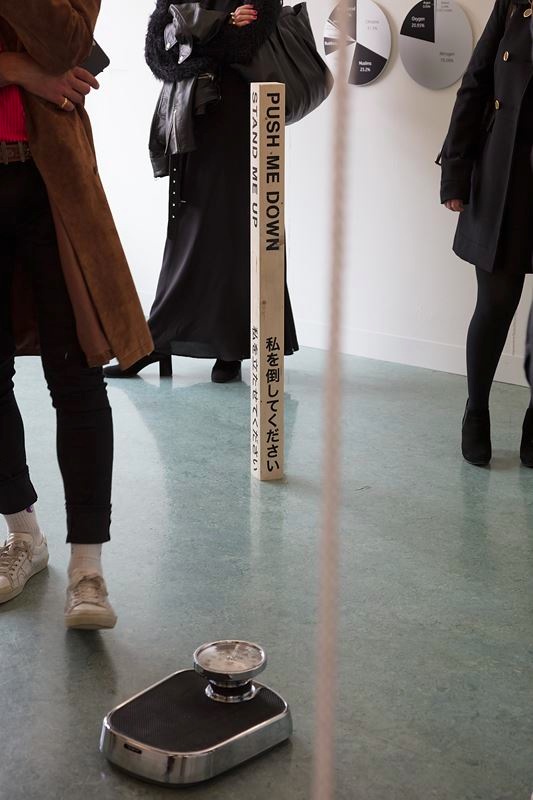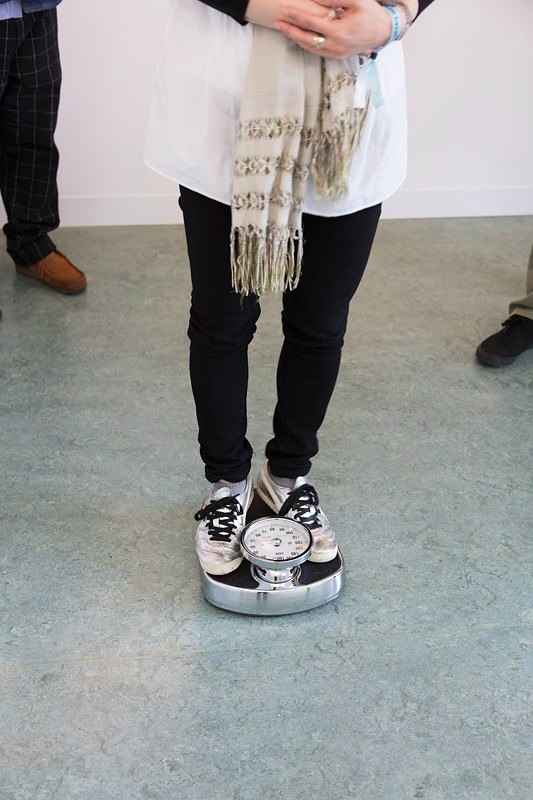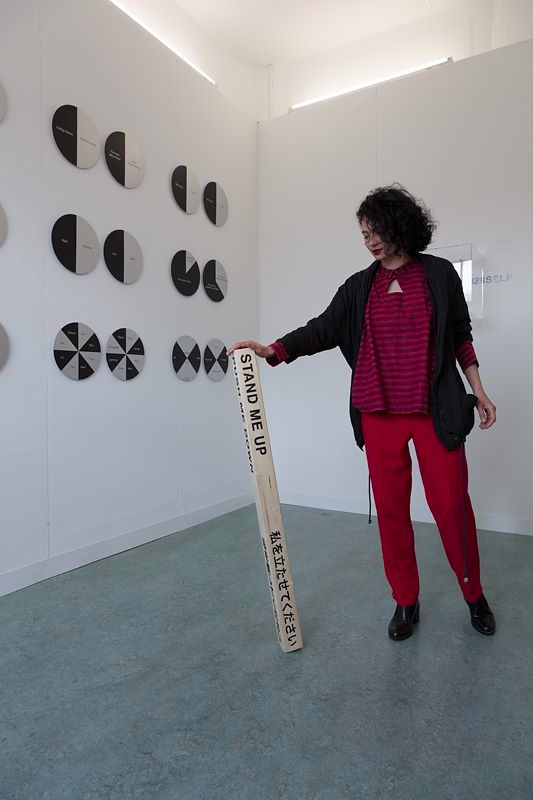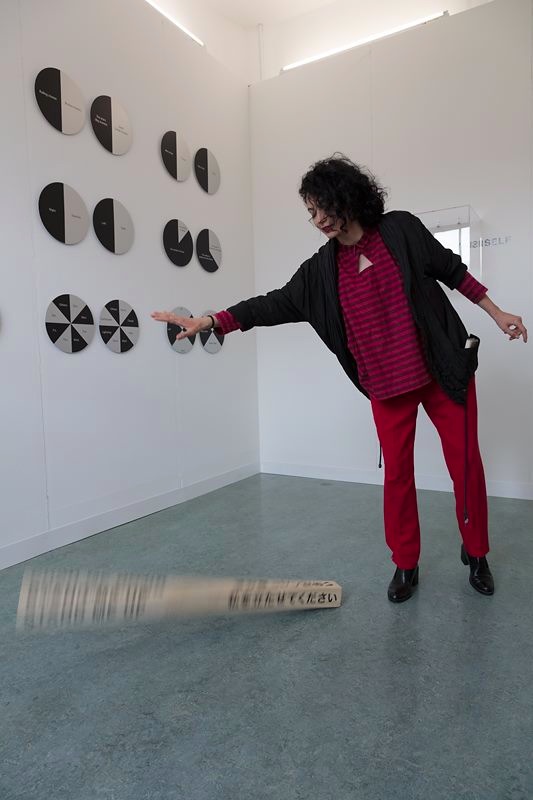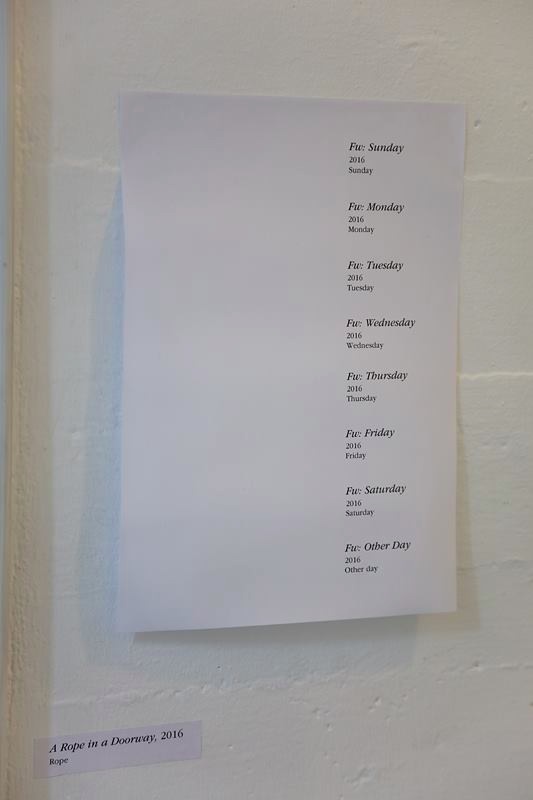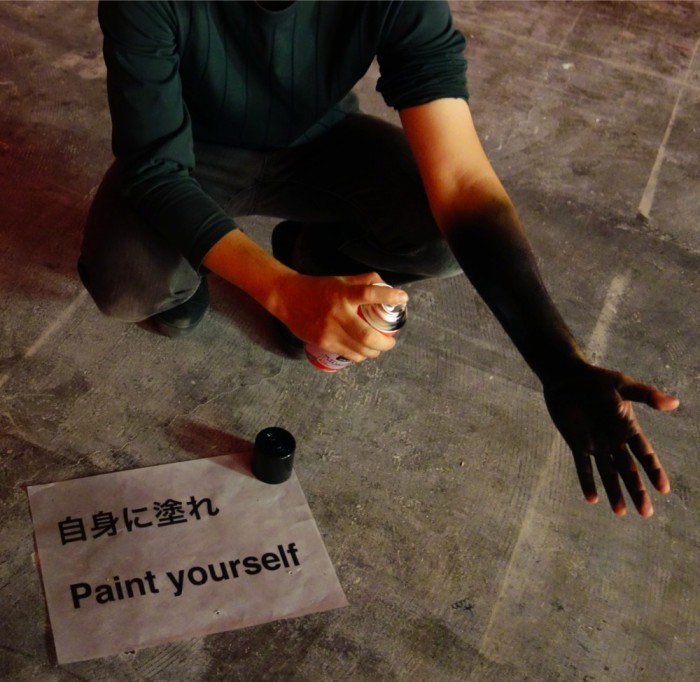
Paint yourself (Black)、2016 (2011), spray can, instructions, visitors. Visitors can paint their own body
Satoshi Hashimoto: The World’s Three Major Round Things: the Sun, the Moon, the Eye
1.20 – 2.19. 2017
January 20 – February 19, 2017
performance: January 21 (Sat), 2017, 18:00-
Opening Reception: January 21 (Sat), 2017, 19 :00-21:00
Hours:
Wednesday – Saturday: 12:00-19:00
Sunday: 12:00-18:00
Closed on Monday, Tuesday and national holidays
Installation view, Satoshi HASHIMOTO : The World’s Three Major Round Things: the Sun, the Moon, the Eye
【Event information】(frequently updated)
1.21 (Sat)
-“An Apple (Tell, Newton, Cinderella)” 18:00, Takashi Fujikawa, Satoshi Hashimoto
1.22 (Sun)
-“Sprinkle Water” 14:00-17:00, Hideki Aoyama, Satoshi Hashimoto
-“Hide/Look for (indoor)” 17:00
1.29 (Sun)
-“Hide/Look for (outdoor)” 15:00, Tsukuru Hashimoto, Satoshi Hashimoto
-“Workshop of Making the Mask #2” 16:00
2.5 (Sun)
-“Move by Train” 18:00-
2.12 (Sun)
“Fw: 1day” by eight programs
-“Fw: Movie Theater” 9:30 – 12:30, TOHO CINEMAS Shinjuku
-“Fw: McDonald’s” 12:30 – 13:30, McDonald’s Seibu Shinjuku Ekimae
-“Fw: Window-Shopping” 14:00 – 16:00, Around Shinjuku Station
-“Fw: Starbucks” 16:00 – 17:00, Starbucks Shinjuku 3-chome
-“Gallery Talk: Katsumasa Matsui x Satoshi Hashimoto” 18:00, AOYAMA MEGURO
-“Fw: Eat Out” 21:30, Around Nakameguro Station
-“Fw: the Movies” 24:00, TSUTAYA Nakameguro, AOYAMA MEGURO
-“Fw: Alcohol” 25:00, AOYAMA MEGURO
2.17 (Fri)
-“Fw: Darkness” 20:00 |Meeting point: Exit of JR Hachioji Station
Please contact hashimoshi@gmail.com beforehand
2.18 (Sat)
-“Sound: Uncertainty Dice(Circle Square)” 13:00 – 19:00
2.19 (Sun)
-“Sound: Mosquito (Circle Circle: REMember)” 13:00 – 19:00
-“Gallery Talk” 18:00
Cooperation: Daisuke Motogi Architecture
We ask for your continued support again for this New Year 2017.
As the New Year’s first event, we will hold an exhibition of the work of Satoshi Hashimoto. This is his first solo exhibition at our gallery in four years since “I was Leonardo da Vinci. I sell my soul. I sell heaven.” (2013).
Hashimoto has created a lot of art through which he involves the viewers and questions their role in the experience of art appreciation in the form of performances, actions, and instructions aimed at inducing the viewers’ own reactions. His sometimes unreasonable instructions and his actions that freely transcend any borders, pose a question to our principle of existence. We usually think, speak, and act as if these actions are entirely of our own free will while, in fact, these behaviors are fundamentally influenced by someone or something. Upon finding the shadows, i.e., a false state of people dressed in borrowed plumes, Hashimoto kidnaps them and asks a question while sitting at their side: “Now you are my hostage. And your guardian is your true self.”
“The weight scale placed in the gallery is not the object of your vision. Conversely, that scale objectifies your mass. The mass of the Earth is 5.972 x 10^24 kg. Your body weight is included in that value. But that proportion is extremely low. The world is almost entirely composed of things other than you. But we actually perceive the world in more complex way.” (“Satoshi Hashimoto: Everything and Others,” text by Katsumasa Matsui)
This exhibition “The World’s Three Major Round Things: the Sun, the Moon, the Eye” is composed of several dozen pieces of art such as three-dimensional artwork, texts, and performances, based on the works from the solo exhibition “Everything and Others” (LISTE 21, Basel, June 2016 (which received a great response) and the “Rolling Stone, Olympics, the Sun, the Moon, Cold Water” (TERATOTERA-Involve, Tokyo, October 2016).
“Pie Charts: Everything and Others” is an artwork which transcendentally expresses diverse segmentations of the world through the medium of pie charts. For instance, there are statistical data which indicate an economic discrepancy where the ‘gross assets of 1% of the world population’ almost equals the ‘gross assets of 99% of the world population.’ In this artwork, a pie chart that schematizes the data is aligned horizontally with a pie chart which indicates that ‘the moon observed from the earth’ is almost as large as ‘the sun observed from the earth.’ In fact, the sun is almost 400 times bigger than the moon (and almost 27,000,000 times larger in mass). Various things which are not normally associative with each other, such as the combination of economical data and astronomical data, are put into comparison. Further, various concepts that are not normally expressed by pie chart are schematized and juxtaposed to other statistical data. This chain of confrontation causes a crack on each segmentation of the world.
In this exhibition, “Pie Charts: Everything and Others” which was created through research in 2013 at Kunisaki peninsula and on Japanese philosopher Baien Miura and was exhibited through an online exhibition “Kunisaki Genzo” (Direction: Mizuki Endo) will be exhibited, through the medium of aluminum plates.
During the term, several performances and events will be held every week, in association with his concept “Abstract Direct Action” expressed in exhibitions such as “MOT Annual 2016: Loose Lips Save Ships” (Museum of Contemporary Art Tokyo) and with his other themes. Details will be announced through our website and SNS.
Please do not miss this opportunity.
=================
Satoshi Hashimoto
Born in 1977. His main exhibitions include “Can’t Go, Please Come” (ARCUS, Ibaraki, 2010), group exhibition “Omnilogue: Journey to the West” (Lalit Kara Academy, New Delhi, 2012), “Arbitrary Decisions and Prejudices: I Divide the Audience” (The National Art Center, Tokyo, 2012), “False Name” (“14 Evenings,” The National Museum of Modern Art, Tokyo, 2012), “I was Leonardo da Vinci. I sell my soul. I sell heaven.” (Aoyama Meguro, Tokyo, 2013), “Nation, Dice, Instruction,” (The Daiwa Anglo-Japanese Foundation, London, 2014), “MOT Annual 2016: Loose Lips Save Ships” (Museum of Contemporary Art Tokyo, 2016), “Everything and Others” (LISTE, Basel, 2016), and “Fw: Outside the Country (Japan-Malaysia)” (International airport, airplane, Malaysia, etc., 2016).
In addition to his activities as a solo artist, Hashimoto actively conducts group activities in collaboration with other artists and critics, such as with An Art User Conference, Kiso Geijutsu – Contemporary Art Think-tank, and ARTISTS’ GUILD.
=================
The World’s Three Major Round Things: the Sun, the Moon, the Eye
The World’s Three Major Round Things (the Sun, the Moon, the Eye), The World’s Three Major Religions (Christianity, Islam, Buddhism), Istanbul Olympics 2020、Tokyo Olympics 1964, Lumber Used for Demonstration, Successive the U.S. President, Clinton, Trump, Dollar (Washington) and Swiss Franc (Giacometti) Which Were Shaved, An Egg, An Apple (Tell, Newton, Cinderella), Traffic Signal、Red, Moth, Black, Malevich “Black Square”, Morris “Untitled (Box for Standing)”, Telephone Box, Two Clocks, Pie Charts: Everything and Others, Total Eclipse of the Sun, Size of an Eyeball and a Black Hole, and others. We can drink cold water and black coffee there and can sleep.


Artist/Artwork/Viewer that Undergoing Disruption
Katsumasa Matsui
What percentage of the weather forecast whose rainfall probability is 100% can go wrong? The fact that we are able to predict the future is closely connected with the origin of our culture. Jane Ellen Harrison pointed out that there is a recognition of periodicity at the origin of idea and representation. When a past event is considered to be the one that is not one-off, and is predicted to happen again in the future, our actions are extended towards the object in the past and future, and the abstract world of representation starts to develop. In other words, our representational culture is based on the time in which the past returns to the future. Therefore, the fact that our logic has little concept of time does not mean the imperfection of the logic, but probably indicates its fundamental motive. A desire for an eternal, unchanging world is running through our culture. But on the other side of the world, irreversible time is progressing and unpredictable future becomes an inevitability. The space of probability and statistics consists of supposing the whole assumed events as a whole (Ω) and dividing it. But there inevitably are “others” that are not included in the assumed whole. Time consistently increases information entropy.
Satoshi Hashimoto intends to discover the area of “others” through the crack of the structure of the world of representational culture. His artwork, paired pie charts, has a oneness which is cracked in two, and points at all the “others” from the fissure. Although he prefers dice as his motif, his expression is not the depiction of statistical space evenly allocated from one to six. For example, in his “Imaginative (False) Dice,” the 12 possibilities of the dice are presented in such depictions as ‘Indeterminate Dice’ which keep on falling and ‘Indeterminate Dice (because of darkness)’ whose pip is invisible due to the darkness. Here, behind the closed statistical world, the other possible worlds are considered which include cheating and unforeseen events.
A structuralized world conceals materiality, mediated by ideas of distinctiveness and relationship. A troublesome figure within the ideal world of souls is nothing less than our bodies. Our bodies, support mediums of our souls while exposed to an irreversible time, often bring a destructive disorder to the time-free world of souls. For this reason, our culture has put taboos around our bodies and has desired them to be covered with furnishings. By wearing clothes, we adopt ourselves to the socially-cast persona while concealing our bodies. Hashimoto’s performance in front of the station, “Please Exchange Your Pants,” in which he asks passerby for an exchange of pants while his pants are halfway down, exposes our identities which are a mixture of exchangeability of our clothes and the non-interchangeable state of our bodies.
In the experience of art appreciation, too, we have acquired the habit of playing the role of an art viewer, which is allocated as one part of the structure of artist/artwork/viewer. Generally, we cannot bring our personal feelings and private affairs in art gallery. Because we must try to interpret the artwork objectively and correctly. Through this process, our individualities are replaced by the roles of abstract viewers without any faces and bodies. The experience of art turns into the one that is reversible and abstract. Hashimoto disrupts the structure regarding art appreciation, artist/artwork/viewer. A hammer and spray paint placed on the gallery floor with instructions such as “You can hammer yourself” and “You can paint yourself” are not objects of the viewer’s vision. Conversely, these tools and instructions objectify the viewers. The viewers become the subjects of actions such as hammering and painting in place of the artist or performer, and at the same time, they become the objects of these acts. In “Arbitrary Decisions and Prejudices: I Divide the Audience,” viewers are lined up in front of the artist and evaluated only through their appearance. Their role as the viewers, produced through clothing and makeup, is evaluated. Here, the roles of the artist, artwork and viewer is reversed and replaced, bringing disorder to the preexisting structure. The viewers of his artwork frequently get bound, trapped, or chased. These burdens are presented to their bodies to help bringing their own bodies back from abstract states and liberate the viewers from the “role of viewers.”
The belief in objectivity and identity of an artwork plays a central role in stabilizing the experience of art appreciation. As currency that stabilizes unstable barter exchange, an artwork becomes a medium in stabilizing an unstable relationship between an artist and a viewer. We fall into an illusion of fetishism as if the meaning and value of an artwork is inherent in the artwork itself. However, the object we see in a Hashimoto’s artwork “Flower” is something that causes a crack in such fetishism. At the entrance of the gallery, a viewer sees a woman’s leg coming out from the ceiling, wearing a high heel, which seems to be a symbol of sexual fetishism. Then the viewer walks into the gallery, and notices a wrinkled piece of paper which comes flying from behind. Looking back, the viewer witnesses a bearded man above the entrance, producing wrinkled pieces of papers with pages torn from art books. Finally the viewer realizes that the woman’s leg seen from the outside of the gallery was actually his leg.
This strange exhibition conducted at the boundary of inside/outside of the gallery brings irreversible time in the experience of art appreciation. Such time is introduced through the process of the art books to be segmented, wrinkled, and scattered and the discontinuous experience of seeing a woman-like man’s leg. Needless to say, the leg remains as the same object regardless of being seen from the inside or outside of the gallery. But the viewer saw a woman’s leg from the outside, and a man’s leg from the inside. We resolve these two conflicting experiences not by integration, but by concealment. The past is reshaped with the interpretation that we did not see a woman’s leg from the beginning. Of course, the experience imprinted in the viewer’s brain will never disappear. The experience is preserved within the body as a memory of a non-existent object. However, the viewer will never see the woman’s leg even if he/she goes back to the gallery entrance. The fact is that our existences are undergoing an irreversible change through these experiences. And the transformation causes a crucial discontinuity on the identity and objectivity of an artwork.
In “FULCRUM,” a viewer overstepped on a board at the gallery entrance and cannot help looking back due to the feeling of imbalance. And the viewer witnesses the artist supporting the board from underneath, lying on his back. The viewer feels regret by discovering the after-the-fact past that he/she stomped on a human being. The irreversibility of time is imprinted on the viewer as a sense of guilt. The fact distracts the craving for eternity that has supported the experience of art appreciation, and leads the viewer to the space of time composed of an irreversible past and an unpredictable future.
In “I was Leonardo da Vinci. I sell my soul. I sell heaven,” after suffering from a shortage of money to live on, Hashimoto finally revealed one secret. In fact, he is the reincarnation of Leonardo da Vinci. Then he sold land in heaven to an art collector which was (according to his claim) depicted in one of Leonardo’s paintings. Through this amazing plot, he shows us the instability which lies at the root of our culture such as art, language, currency, and religion, by condensing the instability into his fraudulent practice. As if it were recurrence of the act of Leonardo wherein he imagined a painting from stains on the wall, and of Sigmund Freud wherein he read an delusion of vulture (unconsciousness of Leonardo) in a Leonardo’s painting, Hashimoto dissolves the idea of ‘artist’ into an imaginative illusion. Because when an artwork collapses within a phantasm of a viewer, the viewer actually emerges as the creator of the artwork, i.e., the artist. The artist, artwork, and viewer become engulfed by the time of disruption where lies and illusions are swirling. The experience prepared by Satoshi Hashimoto reminds us of how the world in which we live has always been unstable.
=================
Supported by Terumo Foundation for Life Sciences and Arts, Japan, the Agency for Cultural Affairs Government of Japan in the fiscal 2016

